Where Will This Toxic Aircraft Carrier End Up? In what could be described as a modern “voyage of the damned,” the Brazilian Navy’s former flagship may be forced to return home. The Turkish Ministry of the Environment revoked its authorization for the vessel to enter the country. The stated reason was the non-receipt of the inventory of hazardous substances on the ship.
Turkey’s decision has been heralded by environmental groups, who feared the damage the retired aircraft carrier could present to the waters of the Mediterranean. The NAe São Paulo, which was retired in 2018, was sold to a Turkish scrapper. It departed from Brazil at the beginning of the month, and was being towed across the Atlantic Ocean reportedly in defiance of international and Brazilian law – the Brazil Federal District Court issued an injunction that banned the transit.
The vessel, which began her service life as the French Navy’s Clemenceau-class aircraft carrier Foch, had departed Brazil on Aug. 4, towed by a Dutch vessel for a 6,000-mile journey to Aliaga, Turkey, where the flattop was to be cut up. Multiple activist groups alleged that the French-built carrier had been exported in violation of the Basel Convention on the Control of Transboundary Movements of Hazardous Wastes and Their Disposal, as well as the Barcelona Convention for the Protection of the Marine Environment and the Coastal Region of the Mediterranean. Several Turkish communities also expressed concerns over the impending arrival and scrapping of the vessel, which they claim would present an unacceptable toxic threat.
A Dead Aircraft Carrier: Lack of Paperwork and Fears of Asbestos
It now appears that the warship will be denied entry into Turkey largely due to a bureaucratic snafu. According to Turkish Minister for the Environment Murat Kurum, the Brazilian government did not send a detailed report on the presence of toxic substances contained in the vessel, as required on Aug. 9 by the Turkish authorities.
Without a response from the Brazilian Institute of the Environment and Renewable Natural Resources, the entry permit for São Paulo was revoked.
Environmental groups around Turkey had been fighting the arrival of the warship, and their biggest fear was the likely presence of asbestos contained within the aging carrier. The amount of the highly carcinogenic substance present on the retired carrier remains unknown. Some sources claim the ship may carry 9.6 tons of the material, while others say it could be closer to around 600 tons.
“We have repeatedly shared that we would not accept the ship without any hesitation and would send it back before it enters our country’s waters in case of any dangerous negativity,” Kurum added. “We closely monitor all stages of the process, not only on the NAe São Paulo ship, but also on all ships. We do not allow any step that could harm our environment and our people.”
Past evidence certainly suggests the amount of asbestos on board could hew closer to the higher estimates, especially as the carrier’s sister ship – the French Navy carrier Clemenceau – contained more than 700 tons of asbestos when she was sent for scrapping in India. That carrier was retired after the current flagship Charles de Gaulle entered service in 2001.
In fact, history is actually repeating itself, as the Clemenceau‘s scrappingbecame an extended and controversial affair that went on for about a decade, after multiple nations refused to accept the warship. After years of negotiations, when the carrier finally left France in late 2005, there were fierce protests about improper disposal and a lack of facilities for the management of toxic waste on the beaches of Alang, India, where the work was to be completed.
The French vessel was subsequently boarded by activists, held by Egyptian authorities, and it was finally blocked from entering Indian waters by the Supreme Court of India. Clemenceau was subsequently ordered to return to France by French President Jacques Chirac. The flattop ended up being dismantled in a specialist yard owned by Able UK near Hartlepool in the United Kingdom in 2009, and work was completed a year later.
Turkey lacks the facilities that Able UK maintains, and perhaps it is wise to reject accepting São Paulo.
Save the Aircraft Carrier?
Brazil acquired the ship in 2000, and it was refitted and recommissioned as the São Paulo, replacing the former British-made Colossus-class carrier operated by Brazil as the Minas Gerais. Though São Paulo increased the capability of the Brazilian navy, it had a remarkably bad service record. During 16 years in service, it never managed more than three months of operations between maintenance periods. Brazil also struggled to deploy the ship due to funding problems, and it was mainly used for pilot training in port.
The ship suffered two fires. There were some calls to modernize the vessel, which could have allowed it to serve until the late 2030s. But in 2017, the Brazilian navy decided that further investment in repair would be uneconomical, and it formally decommissioned her in 2018.
Efforts to save the ship – either as a museum or as a training vessel for the Turkish Navy – failed last year. The latter plan was scuttled because the bilateral agreement between Paris and Brasília stipulated that Brazil would be the ship’s “final user.”
It now appears that the São Paulo will be forced to return to Brazil, so maybe it could indeed be saved as a museum ship. That would likely be the easiest solution. Whether tourists would actually believe that the ship is safe to visit is another question entirely.
A Senior Editor for 1945, Peter Suciu is a Michigan-based writer who has contributed to more than four dozen magazines, newspapers, and websites with over 3,000 published pieces over a twenty-year career in journalism. He regularly writes about military hardware, firearms history, cybersecurity, and international affairs. Peter is also a Contributing Writer for Forbes. You can follow him on Twitter: @PeterSuciu.

